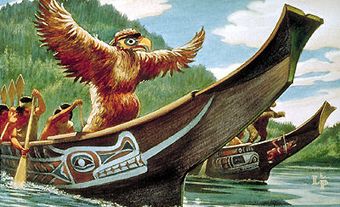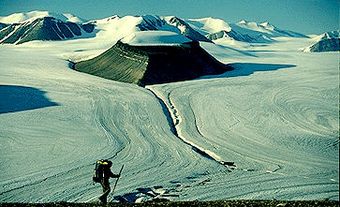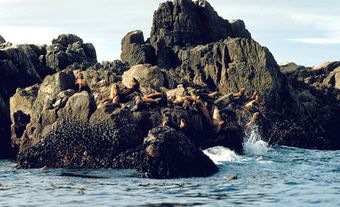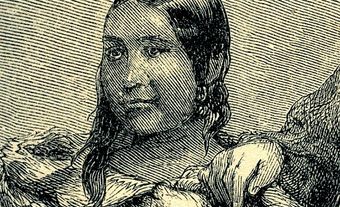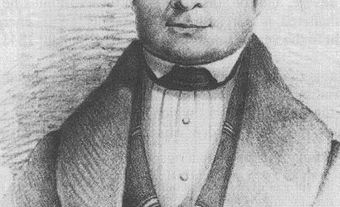The Northwest Coast is the western coast of Canada and the United States along the Pacific Ocean. This term originates from 18th-century European navigators and traders referring to the great arc of the Pacific coast and offshore islands stretching from present-day northern California to an ill-defined point along the Alaska coast—at Prince William Sound or even Cook Inlet. This region is known for its natural beauty and its rich history of Indigenous art (see Northwest Coast Indigenous Art).

Description
The Northwest Coast is warmed by the North Pacific Current and deluged along most of its length by heavy annual precipitation. Dense coniferous forests and abundant vegetation grow in much of this region. The Nass, Skeena and Fraser rivers in British Columbia cut through the landscape. The area is known for its wide beaches, inlets, deep fjords, archipelagos, steep rock faces and coastal snow-capped mountains.
Indigenous Peoples
The Northwest Coast cultural area is one of six indigenous cultural areas contained within what is now Canada. This region is home to many Indigenous Nations.
The Tlingit occupy territories from the northwest tip of British Columbia and the southwest Yukon to the south of the Alaska coast. The Haida live on Haida Gwaii, a group of islands off the north coast of British Columbia.
Along the Nass and Skeena rivers are Tsimshian-speaking peoples, including the Nisga’a and Gitksan (Gitxsan). Strung along the coast from Tsimshian territory to northeast Vancouver Island are the Haisla, Heiltsuk, Oweekeno (Rivers Inlet) and Kwakwaka’wakw. On the west coast of Vancouver Island live the Nuu-chah-nulth.
The remaining peoples include the Coast Salish, a large grouping of Indigenous Nations including the Central Coast Salish and Northern Coast Salish.
See also Northwest Coast Indigenous Peoples in Canada.
European Exploration
The Northwest Coast was one of the last temperate ocean frontiers Europeans explored. Despite the attractions of the North Pacific as the western end of a possible Northwest Passage, the region remained isolated. Distance, the limitations of shipbuilding technology and Spain's control over most of the North and South American littoral prevented much exploration.
Early European voyages in the region, such as by Lorenzo Ferrer Maldonado (1588), Juan de Fuca (1592) and Bartholomew de Fonte (1640), left cartographers confused and without accurate maps.
In 1579, Francis Drake may have reached the 48th parallel north before returning southward to the approximate latitude of present-day San Francisco and then crossing the Pacific, but his exact northernmost location remains unknown.
During the 18th century, interest grew in the North Pacific. Russian expansion into Siberia resulted in expeditions by Vitus Bering to the Bering Strait in 1728. In 1741, Vitus Bering and Aleksei Chirikov may have voyaged the Northwest Coast to around the 55th parallel north. Rumours of this activity spurred the Spanish Crown to order voyages northwards from Mexico. In 1774, Juan Pérez Hernández reached about the 55th parallel north. He reached Haida Gwaii and Nootka Sound.
In 1775, a new expedition under Bruno de Hezeta and Juan Francisco de la Bodega y Quadra sailed northwards to investigate the presence of Russian vessels. Bodega y Quadra reached about the 58th parallel north, around Bucareli Bay. Spain dispatched another major expedition in 1779 along the Northwest Coast.
Between 1777 and 1778, a British expedition led by James Cook crossed the Pacific via Hawaii to the Northwest Coast. Cook was to search for a Northwest Passage and to explore the coastline. He spent nearly a month at Nootka Sound before continuing northward to Alaska and the Aleutian Islands. Later, Cook's men discovered a potentially lucrative trade in the sea otter pelts they had obtained on the Northwest Coast.
After 1785, commercial expeditions from London, Bombay, Calcutta, Macau and American ports such as Boston opened the maritime fur trade. By 1792, at least 21 trading vessels were on the coast. Trading captains included George Dixon, John Meares and Charles William Barkley. The trade of sea otter pelts began in 1786; it reached its apogee in the 1790s before declining after 1812.

Spain did not significantly participate in this fur trade until 1788, when they renewed their voyages to check Russian encroachments southward from Alaska. Esteban José Martínez discovered six Russian posts in Alaska and, after hearing from the traders that Russian ships would soon occupy Nootka Sound, he persuaded the Mexican viceroy to authorize a voyage to occupy the sound for Spain. In 1789, Martínez arrived there and found British and American vessels. His seizure of the British vessels sparked the Nootka Sound Controversy, a clash of imperial interests, almost precipitating a European conflict. However, a series of Conventions provided for a peaceful sharing of the northern ports and resources between the European nations. Spain withdrew in 1795, abandoning the fur trade to the British and Americans.
Meanwhile, the scientific expeditions of the Comte de Lapérouse (1786, France), George Vancouver (1792-94, Britain), Alejandro Malaspina (1791, Spain) and the Sutil and Mexicana (1792, Spain) explored the resources of the Northwest Coast.

In July 1793, Alexander Mackenzie of the North West Company arrived overland down the Bella Coola River to the Pacific. In 1808, Simon Fraser descended what is now known as the Fraser River, and in 1811, David Thompson reached the mouth of the Columbia River. There, he discovered that American traders from John Jacob Astor's Pacific Fur Company had arrived by sea to construct Astoria.
With the amalgamation in 1821 of the Northwest Coast and the Hudson's Bay Company, the European presence ceased to be transitory. In 1821, Russia claimed the northern portions of the coast as its territory, but British and American protests led to the 1825 settlement of the Alaska boundary. The Hudson’s Bay Company built a string of permanent forts to compete with the maritime fur traders. After the negotiation of the Oregon Treaty in 1846, the Hudson’s Bay Company's far western interests centred on Vancouver Island, which became a colony in 1849. Although there was a subsequent competition between the fur traders and settlers, the latter won out. With the emergence of colonies and boundary agreements separating the Russian, British, American and Spanish (later Mexican) spheres, the Northwest Coast as a political concept ceased to exist except as a historical memory.
See also Spanish Exploration.
Impact of the Fur Trade
The sea otter Fur Trade and the corresponding European presence along the Northwest coast significantly impacted the Indigenous peoples of the area. European fur traders and settlers brought disease to the region, most notably smallpox. A major smallpox epidemic in 1862 may have killed as many as 20,000 people.
Additionally, by the beginning of the 19th century, some observers had already noted a decline in the number of sea otters in the region. They predicted the eventual collapse of this fur trade.


 Share on Facebook
Share on Facebook Share on X
Share on X Share by Email
Share by Email Share on Google Classroom
Share on Google Classroom
